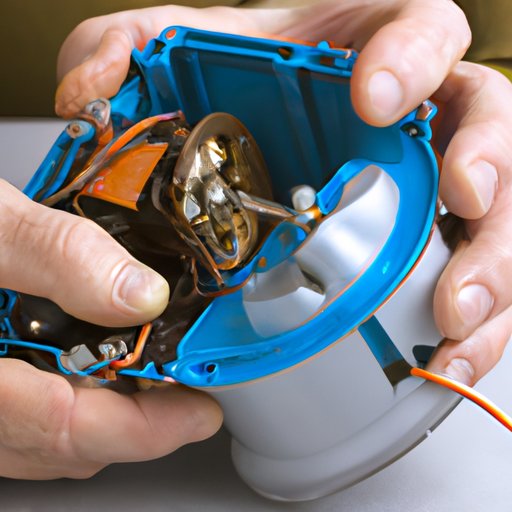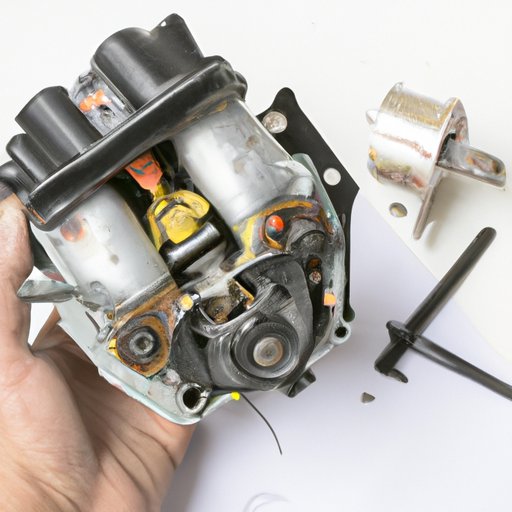Introduction
A starter is an electric motor that helps start an internal combustion engine. It acts as a bridge between the battery and the engine, engaging the flywheel of the engine to turn the crankshaft. Without a working starter, the engine will not start. Replacing a starter is a common repair that many car owners face and can be a costly and time-consuming process. In this article, we’ll explore how much it costs to replace a starter and how to do it yourself.
Step-by-Step Guide to Replacing a Starter
Before attempting to replace a starter, there are several safety considerations to keep in mind. Make sure to disconnect the negative cable from the battery before starting the process. Wear protective gear such as gloves and safety glasses, and use a jack to secure the vehicle if necessary. Additionally, it’s important to make sure you have the right tools and materials for the job.
Tools and materials needed to replace a starter include a socket wrench, screwdriver, starter relay, starter solenoid, and starter wiring harness. Once you have the necessary items, you can begin the process of replacing the starter. The steps for doing so are as follows:
- Disconnect the negative cable from the battery.
- Remove the starter mounting bolts.
- Unplug the starter wiring harness.
- Disconnect the starter relay.
- Remove the starter solenoid.
- Install the new starter solenoid.
- Connect the starter wiring harness.
- Reattach the starter mounting bolts.
- Reconnect the negative cable to the battery.
How Much Does It Cost to Replace a Starter?
The cost of replacing a starter varies depending on several factors including the type of vehicle, the cost of parts, and whether you choose to do the work yourself or hire a professional. According to RepairPal.com, the average cost of replacing a starter ranges from $346 to $472 for most cars. This estimate includes labor costs and the price of the starter itself.
If you choose to do the work yourself, you can save money on labor costs. However, it’s important to factor in the cost of the necessary tools and materials. Depending on the type of vehicle, the cost of these items can range from $20 to $100 or more. It’s also worth noting that some vehicles may require specialized tools that are only available at a professional auto shop.
What Are the Signs of a Failing Starter?
In order to avoid costly repairs, it’s important to know the signs of a failing starter. Common signs of a failing starter include grinding noises when trying to start the engine, slow cranking, and dim headlights. If you notice any of these signs, it’s important to get your starter checked out by a professional.
In addition to the physical signs of a failing starter, there are also diagnostic tests that can be performed to determine the cause of the problem. These tests involve checking the starter circuit for voltage drops, testing the starter relay, and measuring the current draw of the starter motor. If you suspect your starter is failing, it’s best to consult a professional mechanic who can diagnose the issue and recommend a solution.

DIY: How to Replace a Starter Yourself
Replacing a starter can be a daunting task, but it doesn’t have to be. With the right tools and knowledge, you can successfully replace a starter yourself. Doing so can save you money on labor costs and give you peace of mind knowing that the job was done correctly. Here are a few tips to ensure a successful DIY starter replacement.
- Read the vehicle’s service manual for specific instructions on how to replace the starter.
- Make sure you have the right tools and materials for the job.
- Follow all safety precautions when working on the vehicle.
- Carefully follow the step-by-step instructions for replacing the starter.
How to Choose the Right Starter for Your Vehicle
Choosing the right starter for your vehicle is essential to ensure a successful repair. When selecting a starter, consider the size, power output, and compatibility with your vehicle. Additionally, it’s important to make sure the starter is designed for your specific make and model. You should also look for a starter with a good warranty.
To find the right starter, talk to your local auto parts store or research online. Many stores offer free advice and can help you find the right starter for your vehicle. Additionally, there are websites dedicated to helping you find the right starter for your car.
Conclusion
Replacing a starter can be a challenging and expensive process, but understanding the process and costs associated with it can make the job easier. Remember to wear proper safety gear, use the right tools and materials, and follow the step-by-step instructions for replacing the starter. Additionally, it’s important to select the right starter for your vehicle and to be aware of the signs of a failing starter. With the right knowledge and preparation, replacing a starter can be a successful and rewarding experience.
(Note: Is this article not meeting your expectations? Do you have knowledge or insights to share? Unlock new opportunities and expand your reach by joining our authors team. Click Registration to join us and share your expertise with our readers.)
